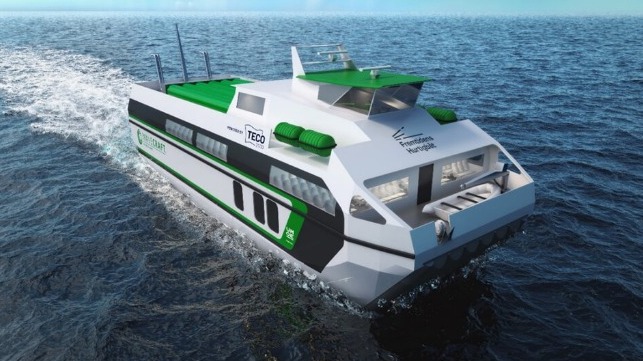Design Approval Sought for World’s First High-Speed Fuel Cell Vessel

A Norwegian project to develop what they are calling the world’s first high-speed vessel employing fuel cells to achieve zero emissions has reached a milestone as it seeks design approval. The project, which is being led by clean-energy company TECO 2030 and builder Umoe Mandal, aims at being a first of its kind, a zero-emission high-speed passenger vessel sailing along the coast without emitting anything but warm air and water.
The design is based on Umoe Mandal’s proven Crew Transfer Vessel (CTV) Surface Effect Ship (SES) technology which uses an air-cushion catamaran design. The design adapts the vessel to be installed with a multimegawatt fuel cell system for full propulsion. The company report the vessel would have a service speed of 35 knots.
“It is a major accomplishment for us to announce our developed partnership with Umoe Mandal and submit all documentation to the Norwegian Maritime Authority for an approval in principle on a ship designed for the future of zero-emission maritime transportation,” says Tore Enger, Group CEO of TECO 2030. “This achievement demonstrates the industry's readiness to embrace commercial and public tenders for passenger vessels powered by hydrogen, thereby contributing to efforts to reduce and eliminate pollution in the maritime industry.”
The project was one of several selected in a competition in July 2022 to develop the high-speed vessel of the future. TECO 230 developed the fuel cell and the catamaran design with SES technology from Umoe Mandal. The project calls for the construction and demonstration of one of the designs in pilot operations by 2025.
The companies have recently delivered the documentation package to the Norwegian Maritime Authority for an approval in principle application for their design for the fuel cell high-speed vessel design. Few details were reported about the concept, but according to the companies in addition to the 35 knot speed, the ship will have a minimum range of 160 nautical miles and carry 275 passengers.
CTVs are often used during the construction, maintenance, and operation of offshore wind farms. Using the principles of the Umoe Mandal CTV design, the ship would be able to operate in challenging and vulnerable ocean conditions. The design seeks to capture the growing interest in sustainable fuels providing the ability to operate with a low imprint on the surrounding environment.
TECO 2030 and Umoe Mandal report once the vessel design and hydrogen propulsion plant have received the approval in principle, the companies will work together with suppliers to continue the process of reaching final approval for the design.
